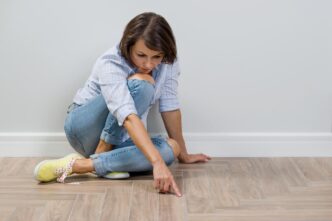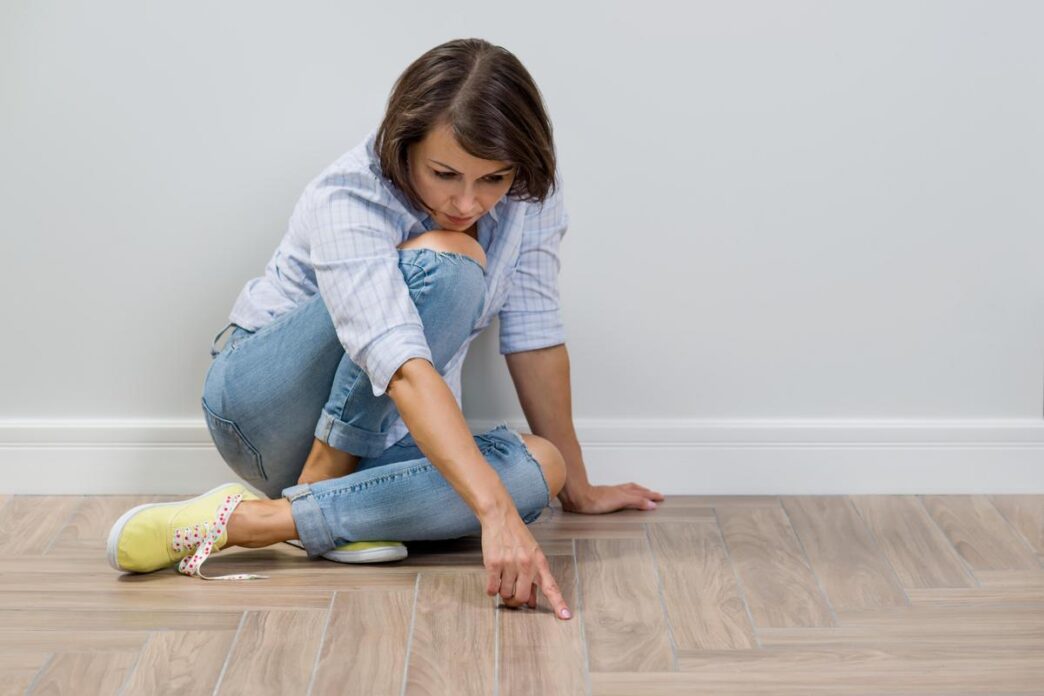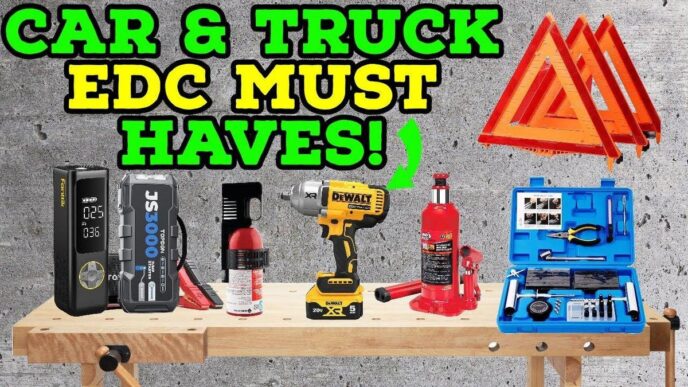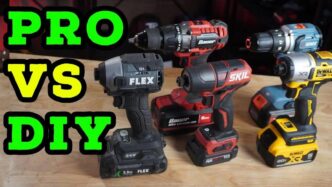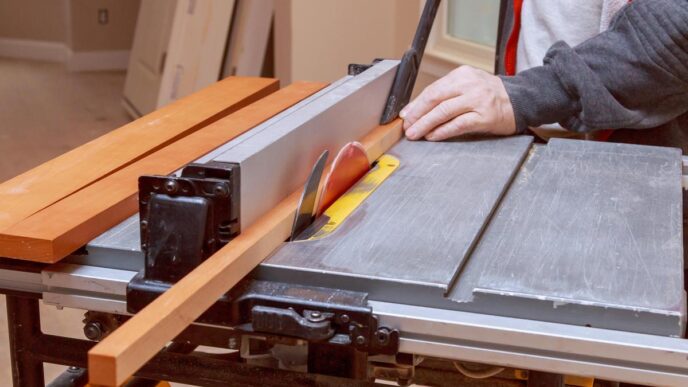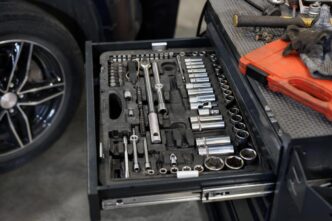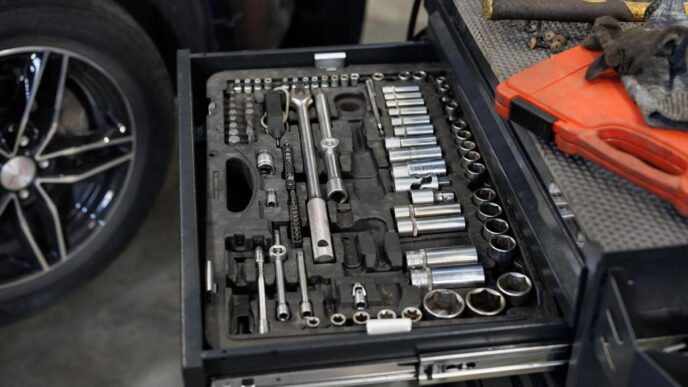Key Takeaways:
- Essential Tools for Squeaky Floors: Drill, hammer, pry bar, putty knife, screwdrivers.
- Essential Materials: Carpenter’s glue, construction adhesive, repair kits like Squeeeeek-No-More.
- Methods for Hardwood Floors: Counter-Snap Kit, talcum powder, wood filler.
- Tile Floor Solutions: Soundproofing underlayment, tighten loose tiles, caulking gaps.
- DIY Methods: Hammer and shim, lubricants like talcum powder, glue for undersides.
- Prevention Tips: Level subfloor, proper installation, regular maintenance, manage humidity.
- Professional Help Needed: Persistent squeaks, water damage, antique floors.
- Causes of Squeaks: Dry/loose materials, humidity, floor movement.
- Best Lubricants: Talcum powder, floor squeak prevention sprays, powdered graphite.
You’ve heard it time and time again: a squeaky floor can drive you nuts. Whether your floor is wood or tile, those annoying creaks seem to pop up at the worst times. If you’re tired of tiptoeing, you’re in the right place. In this guide, I’ll show you the easiest and most effective solutions to silence those annoying squeaks once and for all. Let’s dive in and make peace with your flooring!
What Tools and Materials Are Essential for Fixing Squeaky Floors?
To tackle squeaky floors, we need the proper tools. A drill is one of the most vital tools for this job. It helps to secure loose boards or floor sections. You’ll also need a hammer and pry bar. These help lift boards when repairs are needed under them. A putty knife comes in handy for applying wood fillers. We can’t skip manual and electric screwdrivers, either. They let us tighten any loose screws under the floor.
Now, let’s talk about essential materials. For hardwood floors, carpenter’s glue is key. It strengthens any loose connections. Construction adhesive is also important when filling gaps. It creates a strong bond between the subfloor and joists.
Some useful repair kits can make the job easier, like the Squeeeeek-No-More Kit. It’s perfect for fixing squeaky carpeted floors without causing damage. We might also consider wood shims and wood putty. Shims stabilize the floor by filling gaps, while putty hides any visible screw holes. If you have more detailed requests, you can check out these DIY repair guides for more advice on specific products and their use.
How Can You Fix Squeaky Hardwood Floors?
The good news is you can fix squeaky wood floors without hiring help. One handy method is the Counter-Snap Kit. This does a great job of stopping squeaks. You start by drilling a small hole, about 3/32-inch wide. Then, you insert a special screw that breaks off below the floor surface. Next, use wood putty to fill the hole and make it smooth.
Wood filler and simple lubricants like talcum powder can help too. For gaps between floorboards, use wood filler. Fill the gap, let it dry, and then sand it smoothly to the floor. The powder works best if sprinkled between boards. Wipe away extra powder once it’s in place.
Lubricating your floors can be another solution. This means oiling the spots where squeaks happen. Simple techniques, like using a putty knife to spread lubricants, can get the job done. Keep your favorite technique in mind to fix squeaky floors.
Remember, if a method doesn’t fix the squeak, it’s smart to try another one. Different floors may need different fixes to stop the squeaks for good.
What Are the Methods to Fix Squeaky Tile Floors?
Ever walked across a room and been startled by the squeak of the tile floors beneath your feet? Fixing squeaky tile floors can improve your home’s comfort and silence those annoying sounds. When dealing with tile floor noise problems, there are three methods that work best: soundproofing, tightening loose tiles, and using caulk.
Soundproofing Solutions for Tile Floors: Soundproofing underlayment can keep tile floors quiet. It adds a layer that absorbs noise and prevents sound from bouncing off the tiles. This solution is great for reducing noise and maintaining the peace in your home.
Tightening Loose Tiles: Loose tiles can squeak as they move. If this happens, the solution might be simple. Check if the tiles wiggle. If they do, apply tile adhesive under each loose tile. Press them firmly in place, then let them set.
Using Caulk to Reduce Tile Floor Noise: Applying caulk to gaps between tiles can also lessen noise. It fills small spaces where tiles meet walls or each other. Use a caulking gun to run a bead between gaps. Let it dry before walking on it. Maintaining your tile floor can keep it as squeak-free as a whisper.
What Are DIY Solutions for Repairing Floor Squeaks?
You don’t need to be a carpenter to silence squeaky floors. Many simple and effective solutions can easily be done at home. One method, which works well for hardwood, is the hammer and shim technique. First, check the spaces between floorboards and joists. Once found, tap a wood shim into the gap to stop the noise. Make sure not to hammer too hard, or the floor may lift.
Locating the exact spot of a squeak can be challenging. Walk slowly over the floor and listen for creaks. Mark each spot with tape. Doing this helps target areas that need fixing. Remember, fixing floors doesn’t always require nails or screws. There are home remedies, like talcum powder, to sprinkle between floorboards. The powder reduces friction that causes squeaks.
If you can reach the floor underside, apply some glue and press it into gaps. This fills the space, quieting the noise. Such easy methods save you from costly repairs. To find more solutions for DIY squeaky floor repair, click here. Be patient, and soon your floors will be quiet again.
How Can You Prevent Future Floor Squeaks?
Let’s talk about how to avoid squeaky floors. First, proper installation is key. When you install new floors, focus on a level subfloor. This foundation prevents movement that causes squeaks. Use the best nails and screws, and don’t skip expansion gaps. These gaps let wood expand during hot months without warping.
Regular maintenance also plays a huge role. Inspect your floors often for early signs of wear. Tighten loose boards with screws to keep everything snug. Keeping floors clean helps, too. Dust and debris can sneak into seams and cause creaking. Lubricate high-traffic areas once a year using a product like talcum powder.
Seasonal maintenance includes managing humidity levels. Wood floors shrink and expand with weather changes. Too much moisture makes wood swell, leading to more squeaks. Use a dehumidifier in summer to stop this. In winter, add moisture to the air with a humidifier to help. Just remember, maintaining balance is key for smooth floors.
By following these steps, you can sleep soundly without the annoying sounds of squeaking floors. Choose careful installation and regular checks to stop squeaks before they start.
When Should You Consider Calling a Professional?
Signs DIY Isn’t Enough
Sometimes, squeaky floors mean more than just annoying sounds. If you try fixing, but the noise still stays, something bigger might be wrong. Look for things like sagging floors or boards coming loose. If your attempts with special tools or methods don’t work, it’s time to rethink your approach.
Situations Requiring Professional Intervention
Floor squeaks from water damage or old flooring call for experts. These problems need careful fixes you can’t do yourself. If the floor is uneven or there are gaps in the boards, these are jobs for a professional. Antique floors may need specific care to avoid damage.
How to Choose the Right Floor Repair Specialist
First, get recommendations from friends or neighbors. Check if the repair specialist has good reviews online. Compare several quotes to see who offers fair rates. Ensure they provide a warranty for their work, as this shows they stand by their repairs. With careful selection, you ensure your floor gets the best treatment.
What Are the Common Causes of Squeaky Floors?
Squeaky floors can be a real nuisance. But why do floors squeak? The answer often lies in dry or loose materials. Structural problems can cause squeaks. Loose nails or weak joists are key culprits. Nails and joists hold your floors steady. When they’re loose, you hear the noise.
Humidity also affects floor sounds and can make your floorboards creak. Wood expands when wet and shrinks when dry. This constant change can loosen joints, causing noise over time.
Floor movement plays a role, too. As people walk, floorboards shift. This movement can rub against fasteners or each other, causing noise. Over time, the movement leads to noisier floors due to increased friction.
Understanding these common causes helps in fixing squeaky floors. You can then use specific tools and methods, like those covered in this resource, to get rid of the annoying sounds. Addressing these areas will reduce the noise in your home, making it quieter and more comfortable. Fixing squeaks often starts with pinpointing these reasons.
What Are the Best Lubricants for Squeaky Floors?
Do your floors squeak and creak with every step? You’re not alone. I’ve tried many fixes, but lubricants are some of the easiest solutions. One simple trick is using talcum powder. You sprinkle talcum powder between the squeaky floorboards. Then, step on the boards to work it in. This reduces noise by filling gaps where the boards rub against each other.
Next, let’s consider floor squeak prevention sprays. These sprays are effective because they penetrate deeper into crevices. The spray stops the friction between the boards, addressing the root cause of the squeak. Keep in mind, not all sprays work on all floor types.
Now, what other lubricants are good? Some people recommend using powdered graphite, which is very effective. Find powdered graphite in hardware stores. It works like talcum powder but lasts longer. Just apply it in small amounts and walk it into the cracks.
Keep your floor clean and dry when using these methods. Moisture can worsen the squeaks. To learn more, this link might help with other floor care tips.
Conclusion
Fixing squeaky floors is simpler than it seems. With the right tools and methods, you can tackle wood, tile, and other floor types. We’ve explored the best fixes, like using repair kits and household solutions, and when professional help might be needed. Remember the importance of proper installation, regular checks, and humidity control to prevent future issues. With this knowledge, you can manage floor noise and ensure a squeak-free home. Whether you’re fixing or preventing, you’re ready to make your floors silent once more. Now, let’s get to work and silence those squeaks!
